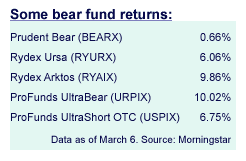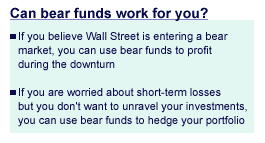|
Bear funds wake up
|
 |
March 8, 2001: 6:52 a.m. ET
Bear funds are delivering some of the best returns on Wall Street
By Staff Writer Martine Costello
|
NEW YORK (CNNfn) - Fund manager David Tice has never been more sure of anything in his life. Like it or not, he says, Wall Street is in a bear market.
Tice, of Prudent Bear Fund, sees losses on the horizon for business-to-business stocks, telecom equipment makers and financial stocks. Auto stocks, contract manufacturers ... the list goes on.
"We think the days of buy-and-hold are over," Tice said. "It's been an 18-year, uninterrupted secular bull market. And when that ends, you get a secular bear market."
 While U.S. stocks have been on the rebound this week, heavy losses across the board in 2001 have hurt most traditional mutual funds. While U.S. stocks have been on the rebound this week, heavy losses across the board in 2001 have hurt most traditional mutual funds.
Among the only winners these days are a small squad of so-called "bear" funds that short stocks, buy futures contracts and use other strategies to profit in down markets.
While the average domestic stock fund is down 5.5 percent year-to-date as of March 6, bear funds are up as much as about 10 percent, according to Chicago fund-tracker Morningstar.
Check your mutual funds on CNNfn.com.
"It's the rationale of not putting all of your eggs in one basket, for not betting that (Fed Chairman) Alan Greenspan can save the economy," Tice said.
How the strategies work
In its simplest definition, a short sale is when you bet the price of a stock will fall. You borrow the stock from a broker at a certain price and sell it. If you're right and the price falls, you buy back the stock at a lower price, repay the broker and pocket the difference.
 When you use leverage, you're betting a small amount of money on an investment of much greater value, amplifying the potential risks and rewards. Buying stock on margin – when you put a tiny portion down on its value -- is a form of leverage investing, Morningstar said. A futures contract is an agreement to buy or sell at a certain price. When you use leverage, you're betting a small amount of money on an investment of much greater value, amplifying the potential risks and rewards. Buying stock on margin – when you put a tiny portion down on its value -- is a form of leverage investing, Morningstar said. A futures contract is an agreement to buy or sell at a certain price.
Short selling by mutual funds is relatively new, allowed only because of the repeal of the so-called "short-short" rule in the Taxpayer Relief Act of 1997.
The rule had prevented funds from earning more than 30 percent of their profit from short-selling. Market-neutral funds, which use a combination of traditional "long positions" and short positions, debuted not long after the repeal of the short-short rule.
How you can benefit
While some analysts are skeptical, bear fund pros argue that you can use the funds to hedge your portfolio against a downturn. Market timers who believe Wall Street is heading into bearish times can also use the funds to ride the wave. Or, you could use the funds in a bull market to protect big gains.
 "These funds have an extremely conservative use," said Charles Tennes, senior vice president of Rydex Funds, which has five funds that use short strategies. Rydex Ursa Fund aims to deliver the opposite of the S&P 500, while Rydex Arktos Fund looks to mirror the inverse of the Nasdaq 100 Index. "These funds have an extremely conservative use," said Charles Tennes, senior vice president of Rydex Funds, which has five funds that use short strategies. Rydex Ursa Fund aims to deliver the opposite of the S&P 500, while Rydex Arktos Fund looks to mirror the inverse of the Nasdaq 100 Index.
Rydex has two other funds that use leverage to deliver twice the opposite returns of the S&P 500 and the Nasdaq 100, Rydex Dynamic Tempest 500 and Rydex Dynamic Venture 100 Fund.
A fifth fund, Rydex Juno, shorts U.S. Treasurys.
For example, let's say you own $100,000 in an S&P 500 Index fund. You could short a portion of it -- say, 20 percent -- by buying $20,000 in an S&P 500 bear fund.
"You reduce your exposure without eliminating it," Tennes said.
Michael Saphir chairman of ProFunds, argued the funds are a tool that help investors shape their portfolios.
ProFunds has three bear funds, all indexers, including ProFunds UltraBear and ProFunds UltraShort OTC. Both funds use S&P 500 futures and options contracts, as well as "swap agreements." In a swap agreement, an investor arranges with a broker or bank to pay a certain amount in exchange for an income stream equal to the inverse of the S&P 500, Saphir said.
Optimists welcome to invest
You don't necessarily need to be a pessimist to invest in bear funds, Saphir said.
For example, let's say you own $100,000 in tech funds. If you're worried about short-term market losses, you may be tempted to sell. But that will trigger transaction costs and possibly capital gains. Instead, you can invest in a Nasdaq 100 bear fund.
 "We think of our funds as short-term plays," Saphir said. "It's like someone who gets insurance on their life or property. Are they pessimists? No. It's the same thing using a bear fund. Long-term, you might (believe) things are going to be great." "We think of our funds as short-term plays," Saphir said. "It's like someone who gets insurance on their life or property. Are they pessimists? No. It's the same thing using a bear fund. Long-term, you might (believe) things are going to be great."
A lukewarm reception
Still, investors haven't been rushing to get into funds since the market has been writhing in volatility.
One fund, BearGuard Fund, which had been the first short-only fund when it debuted in 1999, is closing at the end of the month because of small asset size, said manager Paul McIntyre. Ironically, the fund earned 26 percent in 2000, when most parts of the fund world suffered. The fund earned another 18.8 percent in February.
"We just weren't able to get enough interest or understanding from a short-only fund," McIntyre said.
Tennes, of Rydex Funds, said he's also surprised asset size hasn't taken off.
"We're not exactly sure why, but one possibility is although people are discouraged by the performance in the market recently, there may not be a lot of fear," Tennes said. "It may be, despite the slide, that there's still a large degree of optimism in the market."
But, McIntyre said his firm was hired in January by Marketocracy to launch a hedged technology fund, Marketocracy Technology Plus Fund. (Data isn't yet available on the fund from Morningstar, but its ticker is TPFQX). The fund is using "longs" and "shorts" and is up slightly, compared with an average tech fund loss of 22 percent.
Marketocracy Technology Plus Fund is shorting two stocks, Amazon.com (AMZN: Research, Estimates) and Peregrine Systems (PRGN: Research, Estimates), McIntyre said.
"Not just bear funds, but funds that employ methods to control their risk, like hedging, may be some of the best performers over the next few years," McIntyre said. 
|
|
|
|
|
 |

|

